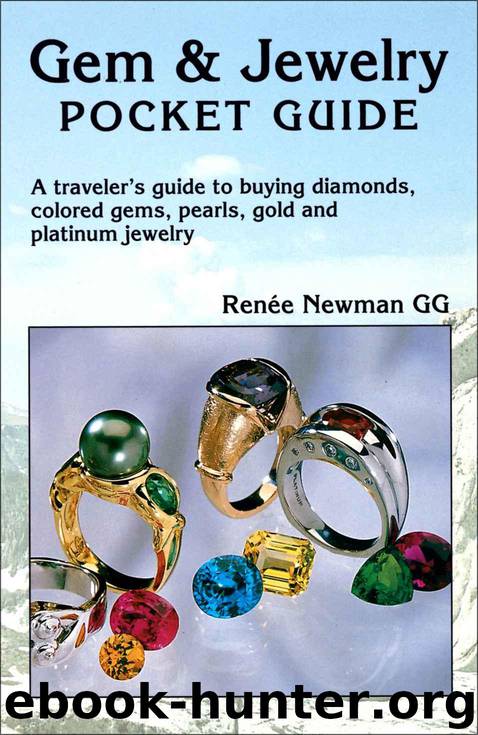Gem & Jewelry Pocket Guide: A traveler's guide to buying diamonds, colored gems, pearls, gold and platinum jewelry by Newman Renee

Author:Newman, Renee [Newman, Renee]
Language: eng
Format: azw3, epub
ISBN: 9780929975498
Publisher: International Jewelry Publications
Published: 2015-01-19T16:00:00+00:00
Fig. 4.69 Tourmaline rings by Linda Quinn. Photo by Chris Rockafellow. Fig. 4.70 Bicolor tourmaline cut by Tatyana Vyalkin. Pendant & photo by Sara Commers.
PINK or RED TOURMALINE: The discovery of pink tourmaline in southern California in 1898 helped popularize this stone. Red and pink tourmaline are also mined in Afghanistan, Brazil, Maine, Nigeria, Russia and Madagascar. RUBELLITE is a trade name applied to red and hot-pink tourmaline. True-red rubellites often have a low clarity. Pink and red tourmalines are commonly irradiated to intensify their color. The stones are not radioactive and the color is relatively stable. However, strong heat like that from a display window or a jeweler’s torch can cause the color to fade. Sometimes rubellite is treated with fillers to improve its clarity. Even when treated, you should expect it to have a lower clarity than other transparent tourmalines
BLUE TOURMALINE (INDICOLITE or INDIGOLITE): The term “indicolite” generally refers to blue tourmaline colored primarily by iron; it’s not used an alternative name for blue cuprian tourmaline. Indicolite comes in various shades of blue, but frequently, it’s a dark greenish or grayish blue. The color is often lightened with heat treatment. Brazil is the most famous source of indicolite but it’s also been found in Russia, Madagascar, Mozambique, Nigeria and the U.S.
YELLOW, ORANGE, BROWN or GOLDEN TOURMALINE: Yellow and orange tourmaline occur naturally but are sometimes produced by irradiating light yellow or green tourmaline. Heat may cause the resulting color to fade. Orange and yellow tourmalines are not easy to find. Most of them come from Tanzania, but some are from Brazil, Malawi, Nigeria, Nepal and Pakistan.
BICOLORED or MULTICOLORED TOURMALINE: The pink and green variety is the most common type, but stones can also be pink and colorless or blue and green. Some stones have more than two colors. The most valued stones have distinct saturated colors with sharp boundaries and no fractures. Green and pink slices of crystal tourmaline that have concentric color banding are called watermelon tourmaline. Multicolored tourmaline is found in Afghanistan, Brazil, Madagascar, Mozambique, Nigeria, Tanzania and the U. S.
CAT'S-EYE TOURMALINE: This is found in a variety of colors but pink and green are less difficult to find than red or blue colors. Cat’s-eye tourmaline is occasionally treated with epoxy fillers to improve transparency and seal the tubes causing the cat’s-eye.
Download
Gem & Jewelry Pocket Guide: A traveler's guide to buying diamonds, colored gems, pearls, gold and platinum jewelry by Newman Renee.epub
This site does not store any files on its server. We only index and link to content provided by other sites. Please contact the content providers to delete copyright contents if any and email us, we'll remove relevant links or contents immediately.
How to Be a Bawse: A Guide to Conquering Life by Lilly Singh(7167)
Spare by Prince Harry The Duke of Sussex(4807)
Millionaire: The Philanderer, Gambler, and Duelist Who Invented Modern Finance by Janet Gleeson(4118)
Machine Learning at Scale with H2O by Gregory Keys | David Whiting(3670)
Harry Potter 02 & The Chamber Of Secrets (Illustrated) by J.K. Rowling(3560)
Never by Ken Follett(3551)
The Heroin Diaries by Nikki Sixx(3328)
Urban Outlaw by Magnus Walker(3251)
Harry Potter and the Prisoner of Azkaban (Book 3) by J. K. Rowling(3126)
Japanese Design by Patricia J. Graham(3008)
Fairy Tale by Stephen King(2976)
The Man Who Died Twice by Richard Osman(2824)
The Club by A.L. Brooks(2758)
Stacked Decks by The Rotenberg Collection(2701)
Will by Will Smith(2595)
Harry Potter and the Deathly Hallows (7) by J.K. Rowling(2556)
Churchill by Paul Johnson(2374)
The Chimp Paradox by Peters Dr Steve(2233)
Borders by unknow(2122)
